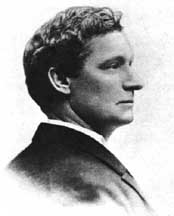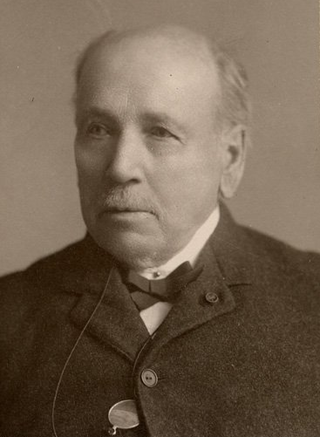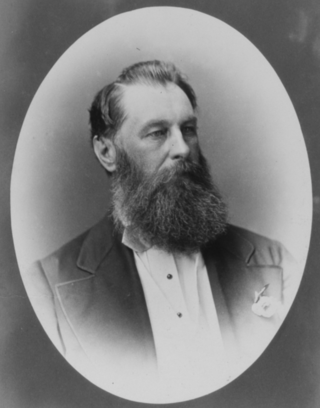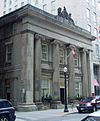
Sir Sandford Fleming was a Scottish Canadian engineer and inventor. Born and raised in Scotland, he emigrated to colonial Canada at the age of 18. He promoted worldwide standard time zones, a prime meridian, and use of the 24-hour clock as key elements to communicating the accurate time, all of which influenced the creation of Coordinated Universal Time. He designed Canada's first postage stamp, produced a great deal of work in the fields of land surveying and map making, engineered much of the Intercolonial Railway and the first several hundred kilometers of the Canadian Pacific Railway, and was a founding member of the Royal Society of Canada and founder of the Canadian Institute.

Events from the year 1881 in Canada.
Thomas Seaton Scott was an English-born Canadian architect. Born in Birkenhead, England he immigrated to Canada as a young man first settling in Montreal. He was hired by the Grand Trunk Railway and worked for them on a number of structures including the Union Station in Toronto and Bonaventure Station in Montreal.

Government House was the official residence of the lieutenant governor of Upper Canada and Ontario, Canada. Four buildings were used for this purpose, none of which exist today, making Ontario one of four provinces not to have an official vice-regal residence.

Richard Alfred Waite was a British-born American architect in the late 19th century.

Canada's grand railway hotels are a series of railway hotels across the country, each a local and national landmark, and most of which are icons of Canadian history and architecture; some are considered to be the grand hotels of the British Empire. Each hotel was originally built by the Canadian railway companies, or the railways acted as a catalyst for the hotel's construction. The hotels were designed to serve the passengers of the country's then expanding rail network, and they celebrated rail travel in style.

The Central Experimental Farm (CEF), commonly known as the Experimental Farm, is an agricultural facility, working farm, and research centre of the Science and Technology Branch, formerly the Research Branch, of Agriculture and Agri-Food Canada. As the name indicates, this farm is centrally located in and now surrounded by the City of Ottawa, Ontario, Canada. The 4 square kilometres (1.5 sq mi) farm is a National Historic Site of Canada and most buildings are protected and preserved as heritage buildings.

Kivas Tully, ISO was an Irish-Canadian architect.

St. George's Cathedral in Kingston, Ontario, Canada, is the cathedral church of the Anglican Diocese of Ontario.

Charles Baillairgé was an architect, land surveyor, civil engineer, and an author.
Frederick Preston Rubidge,, was a surveyor and an architect. He was born in England and emigrated to Upper Canada around 1825 where he took his training.

John Ostell architect, surveyor and manufacturer, was born in London, England and emigrated to Canada in 1834, where he apprenticed himself to a Montreal surveyor André Trudeau to learn French methods of surveying. In 1837 he married Eleonore Gauvin, a member of a prominent French Catholic family in the city. His marriage ensured entry to French Canadian society, he was appointed diocesan architect for Montreal. In 1849 he formed a partnership with his nephew Henri-Maurice Perrault (1828–1903), this was the formation of one of the first architectural dynasties in Canada.

Francis Riley Heakes was a Canadian architect. He studied under Kivas Tully in the mid-1880s.

Frederic Thomas Nicholls was a Canadian businessman, electrical engineer and politician. He was a Conservative senator representing the senatorial division of Toronto, Ontario from 1917 to 1921.
Samuel George Curry was a Canadian architect who practiced in Toronto as the junior partner of several of Toronto’s leading architects, among them Frank Darling and from 1892 Darling's partner John A. Pearson, Henry Sproatt, Francis S. Baker, Ernest Rolph and W. F. Sparling.

Joseph Sheard was an English architect and politician. He was Mayor of Toronto from 1871 to 1872.

William George Storm (1826–1892) was a Canadian architect who designed a number of prominent monuments in Toronto, Ontario.

Henry Langley was a Canadian architect based in Toronto. He was active from 1854 to 1907. Among the first architects born and trained in Canada, he was a founding members of the Royal Canadian Academy of Arts in 1880 and was instrumental in establishing the Ontario Association of Architects in 1889. A conservative in architectural design, he is primarily known for designing numerous churches in the Toronto area, although he designed many secular buildings as well including residential, commercial and public buildings. Langley designed 70 churches throughout Ontario. He was the first chair of the Department of Architecture at the University of Toronto, where he taught during the 1880s and 1890s.
George Wallace Gouinlock was a prominent Canadian architect. Gouinlock practiced mostly in Toronto, Ontario, Canada, including several designated buildings at Exhibition Place.


























